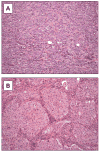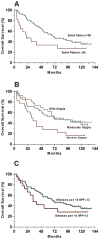Prognostic significance of grading in lung adenocarcinoma
- PMID: 20014400
- PMCID: PMC2846761
- DOI: 10.1002/cncr.24831
Prognostic significance of grading in lung adenocarcinoma
Abstract
Background: Although grading has prognostic significance for many tumor types, a prognostically significant grading system for lung adenocarcinoma has not yet been established. The aim of this study was to evaluate histologic characteristics included in tumor grading systems, establish optimal cutoff values that have the strongest association with overall survival, and develop a grading system incorporating the histopathologic characteristics that the authors found to have prognostic significance in patients with lung adenocarcinoma.
Methods: The authors studied lung adenocarcinomas from 85 consecutive patients, and evaluated the percentage of solid pattern (as a reflection of tumor architecture), the degree of cytologic atypia, and the mitotic count.
Results: In univariate analysis, overall survival was associated significantly with sex (P = .045), age (P = .0008), tumor status (P < .0001), lymph node status (P = .02), solid pattern (P = .046), and cytologic atypia (P = .01), but not with mitotic count (P = .26). On the basis of optimal cutoff values, the authors found that a solid pattern > or = 90% and severe cytologic atypia were the best discriminators of worse outcome. A grading score, computed as the sum of the architecture score and cytologic atypia score (2 = well differentiated, 3 = moderately differentiated, 4 = poorly differentiated), was a significant predictor of overall survival in univariate analysis (median overall survival times, 72.4, 39.5, and 8.7 months for well, moderately, and poorly differentiated adenocarcinoma, respectively; P = .0001). Moreover, grading was an independent predictor of survival in multivariate analysis (P = .002).
Conclusions: The authors describe a grading system that incorporates the percentage of solid pattern and degree of the cytologic atypia that is an independent predictor of survival in patients with lung adenocarcinoma.
Copyright 2009 American Cancer Society.
Figures






Similar articles
-
Histologic features associated with metastatic potential in invasive adenocarcinomas of the lung.Am J Surg Pathol. 2013 Jul;37(7):1100-8. doi: 10.1097/PAS.0b013e31827fcf04. Am J Surg Pathol. 2013. PMID: 23681071
-
Ly6/uPAR-related protein C4.4A as a marker of solid growth pattern and poor prognosis in lung adenocarcinoma.J Thorac Oncol. 2013 Feb;8(2):152-60. doi: 10.1097/JTO.0b013e318279d503. J Thorac Oncol. 2013. PMID: 23287851
-
Primary Tumor Location Is a Useful Predictor for Lymph Node Metastasis and Prognosis in Lung Adenocarcinoma.Clin Lung Cancer. 2017 Jan;18(1):e49-e55. doi: 10.1016/j.cllc.2016.06.002. Epub 2016 Jun 23. Clin Lung Cancer. 2017. PMID: 27426975
-
Prognostic significance of micropapillary pattern in lung adenocarcinoma and expression of apoptosis-related markers: caspase-3, bcl-2, and p53.APMIS. 2011 Sep;119(9):574-580. doi: 10.1111/j.1600-0463.2011.02778.x. Epub 2011 Jun 23. APMIS. 2011. PMID: 21851414 Review.
-
Clinicopathological and prognostic significance of NM23 expression in patients with non-small cell lung cancer: A systematic review and meta-analysis.Medicine (Baltimore). 2021 Nov 24;100(47):e27919. doi: 10.1097/MD.0000000000027919. Medicine (Baltimore). 2021. PMID: 34964763 Free PMC article.
Cited by
-
Pathologic heterogeneity of lung adenocarcinomas: A novel pathologic index predicts survival.Oncotarget. 2016 Oct 25;7(43):70353-70363. doi: 10.18632/oncotarget.11857. Oncotarget. 2016. PMID: 27612421 Free PMC article.
-
Novel prognostic model for stratifying survival in stage I lung adenocarcinoma patients.J Cancer Res Clin Oncol. 2020 Mar;146(3):801-807. doi: 10.1007/s00432-019-03110-y. Epub 2019 Dec 28. J Cancer Res Clin Oncol. 2020. PMID: 31884561 Free PMC article.
-
Identification of significant genes as prognostic markers and potential tumor suppressors in lung adenocarcinoma via bioinformatical analysis.BMC Cancer. 2021 May 26;21(1):616. doi: 10.1186/s12885-021-08308-3. BMC Cancer. 2021. PMID: 34039311 Free PMC article.
-
Tumor islands in resected early-stage lung adenocarcinomas are associated with unique clinicopathologic and molecular characteristics and worse prognosis.Am J Surg Pathol. 2013 Feb;37(2):287-94. doi: 10.1097/PAS.0b013e31826885fb. Am J Surg Pathol. 2013. PMID: 23095504 Free PMC article.
-
Development and validation of a nomogram for predicting overall survival in patients with stage III-N2 lung adenocarcinoma based on the SEER database.Transl Cancer Res. 2023 Oct 31;12(10):2742-2753. doi: 10.21037/tcr-22-2757. Epub 2023 Oct 24. Transl Cancer Res. 2023. PMID: 37969392 Free PMC article.
References
-
- Jemal A, Siegel R, Ward E, Murray T, Xu J, Thun MJ. Cancer statistics, 2007. CA Cancer J Clin. 2007;57(1):43–66. - PubMed
-
- Alberg AJ, Ford JG, Samet JM. Epidemiology of lung cancer: ACCP evidence-based clinical practice guidelines (2nd edition) Chest. 2007;132(3 Suppl):29S–55S. - PubMed
-
- Greene FL, Page DL, Fleming ID, Fritz A, Balch CM, Haller DG, et al. AJCC cancer staging manual. New York, NY: Springer; 2002. pp. 91–8.
-
- Mountain CF. Revisions in the International System for Staging Lung Cancer. Chest. 1997;111(6):1710–7. - PubMed
-
- Detterbeck FC. Lumping, splitting, and sorting. J Thorac Oncol. 2007;2(7):581–2. - PubMed
Publication types
MeSH terms
Grants and funding
LinkOut - more resources
Full Text Sources
Medical

